

Three Easy Ways To Insulate Your Worm Bin - VermicompostingBMP. Drain Flies and other questions for new member. Margaret – thanks for the info.
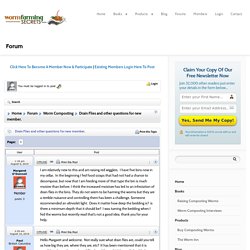
I found this, it might be helpful. 4. Using a Trap for drain Flies: This method is good if the infested place is your kitchen. Take a bowl and fill it with equal amount of sugar, water and white vinegar. Add 5 -10 drops of dish soap. The article also said that these flies live, eat and breed in warm, moist organic environments.
Here is the article I found. Drain Flies As to the 12" of bedding, mine aren't that deep, that's the "recommended" from what I've read. If you look a little further down the forum, you will see a post titled "Wild leaves" or some such. I thought that my bins were ruined when I saw all these odd critters crawling around. When I feed my worms, sometimes I pull back a little of the bedding, spread it around and then bury it. Worm Farm Facts - European Night Crawler. The ENC (Eisenia Hortensis) European Night Crawlers are fast becoming a favorite breed for the worm farm.
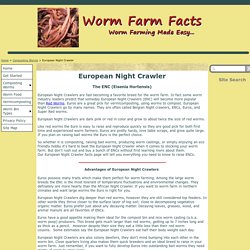
In fact some worm industry leaders predict that someday European Night Crawlers (ENC) will become more popular than Red Worms. Euros are a great pick for vermicomposting, using worms to compost. European Night Crawlers go by many names. They are often called Belgian Night crawlers, ENCs, Euros, and Super Red worms. European Night Crawlers are dark pink or red in color and grow to about twice the size of red worms. Like red worms the Euro is easy to raise and reproduce quickly so they are good pick for both first time and experienced worm farmers. Worm Farming Pests. Back to TOC Worm farming pests do get in on occasions, so I put together a small list that you may want to refer to from time to time.
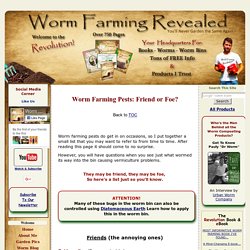
After reading this page it should come to no surprise. However, you will have questions when you see just what wormed its way into the bin causing vermiculture problems. They may be friend, they may be foe, So here's a list just so you'll know. ATTENTION! Friends (the annoying ones) Spider mites (Brown and white) It's not entirely uncommon to find some kind of mite in the bin. These guys aren't necessarily a problem as much as they are a nuisance.
However, if the mites become too populated, they may start to choke out the worms and the worms may look for new residence. Worm Composting in the Winter. 6 Ways to keep your Worm Farm Warm. #4 is my new favorite!Worm Composting Headquarters. Worm Composting in the Winter Your composting worms have three jobs: eat, poop, and make babies.

It’s a good life if you can get it. You’re job as the worm farmer is to make sure the conditions are right for the worms to do their thing. Regulating the temperature in your worm bin is essential to maximize the worms efficiency. Troubleshooting Worm Bins - Cornell Composting. By Jen Fong and Paula Hewitt Fruit Flies Though fruit flies do not pose any health hazards, these little creatures can be a nuisance in the classroom.
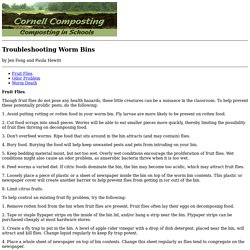
To help prevent these potentially prolific pests, do the following: 1. Get Started - Uncle Jim's Worm Farm. Red Worm Composting. The purpose of this page is provide you with an overview of worm composting.
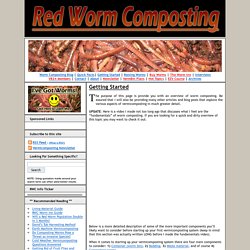
Be assured that I will also be providing many other articles and blog posts that explore the various aspects of vermicomposting in much greater detail. UPDATE: Here is a video I made not too long ago that discusses what I feel are the “fundamentals” of worm composting. If you are looking for a quick and dirty overview of this topic you may want to check it out: Below is a more detailed description of some of the more important components you’ll likely want to consider before starting up your first vermicomposting system (keep in mind that this section was actually written LONG before I made the fundamentals video). When it comes to starting up your vermicomposting system there are four main components to consider: 1) Container (worm bin), 2) Bedding, 3) Waste material, and of course 4) Composting worms.
Container There are a wide variety of options when it comes to choosing the type of worm bin you want to set up. Shopping: Home and Garden: Fertilizers and Soil Additives: Compost: Worms. Vermicomposting: How worms can reduce our waste - Matthew Ross. Composting With Worms. Brief Description A classroom composting experiment demonstrates why worms are called "nature's recyclers.
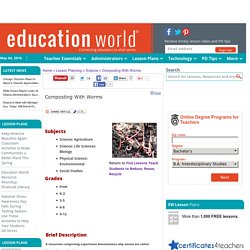
" Objectives Students will predict what will happen in two (control and experiment) containers -- one with soil and trash, the other with soil, trash, and worms. Learn why some people call worms "nature's recyclers. " discuss how worms can help solve environmental problems. Keywords Worms, earthworms, recycle, compost, garbage, trash, biodegradable Materials Needed two see-through plastic containers of the same size, with lids (optimum container size might be a foot square and 6 inches deep); air holes should be punched in sides and lid of container earthworms (See Purchasing Earthworms section below.) Lesson Plan In this experiment students observe firsthand how earthworms transform garbage into compost. Start with two see-through plastic containers of the same size; the containers should have lids. Be sure each container contains equal amounts of soil and garbage items.
Assessment. Amazon. Waste Materials For Worms.